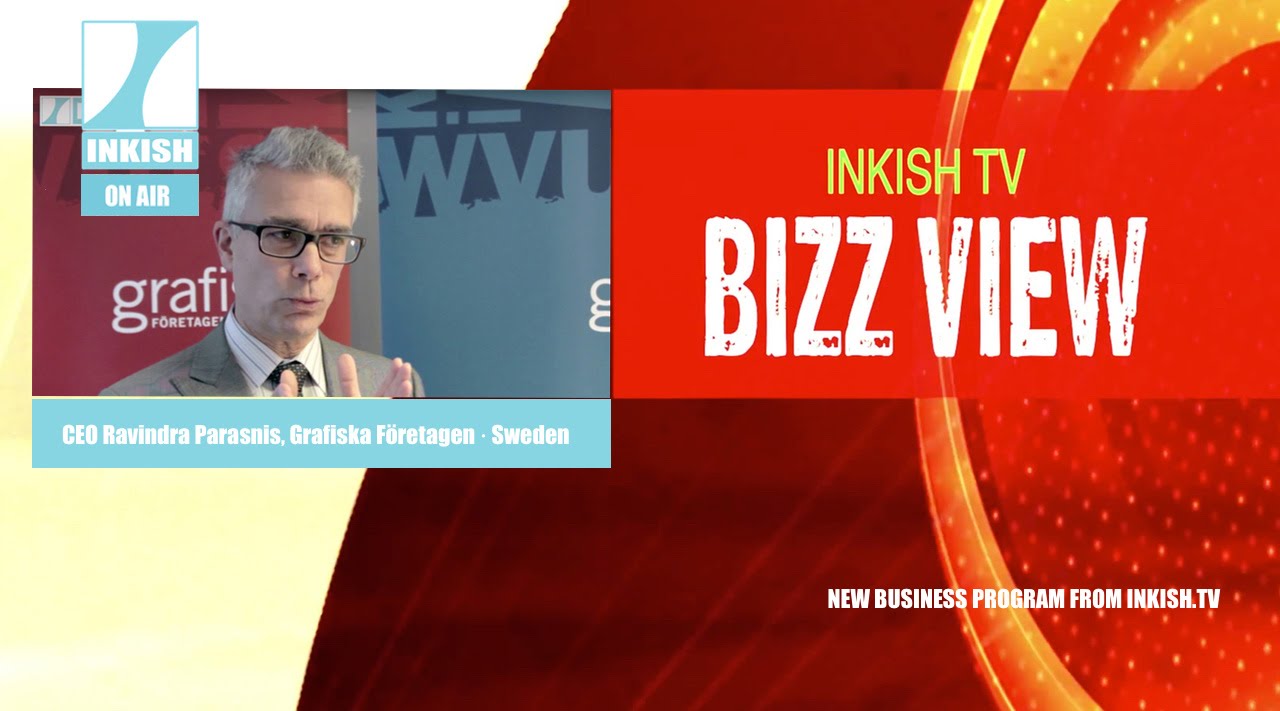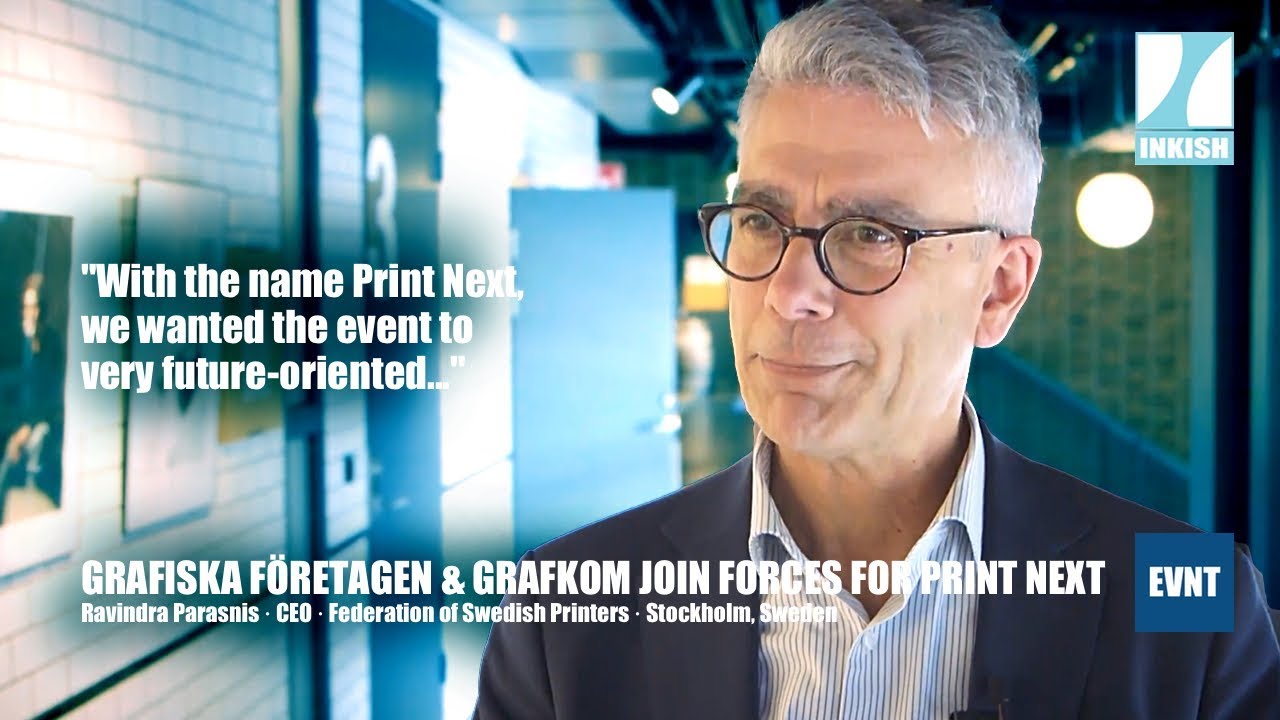INKISH.TV BizzView: CEO Ravindra Parasnis · Grafiska Företagen, Sweden
In BizzView INKISH.TV interviews the top leaders of the printing industry and get their view on where we are and where we are heading. Every episode will ask more or less the same questions, but the answers are very likely to be very different. Each top leader have his own opinion on how the challenges are faces and each top leader of course bring solutions to his market, based on the differences the markets faces. In this first episode please welcome CEO Ravindra Parasnis from Grafiska Företagen i Stockholm, Sweden.
True leaders share their knowledge and their success. It helps an industry and it also helps the leaders to become even better, so sharing knowledge is a key.
One important, crucial part of this organization is of course being representative for employers towards unions, doing the collective agreements etc., and providing the best possible situation for employers versus employees, but more and more it’s also very much about providing platforms for sharing knowledge between members, monitoring market development, providing business intelligence, lobbying activities, looking at environmental issues that might influence our business legislation etc.
I think the requirements are changing. The very foundation is of course, negotiating collective agreements and helping employers with various kinds of issues towards employees, but when I speak to members, what they are really asking for a lot is guidance – What’s going to happen? How should I develop my business? What are the major market trends? What are the new technologies coming on? How do I get new ideas? And that’s really where I think we can play a part and should take a very active role. So in that sense, we are changing. I am about 3-month old into this business. I was the CEO of a packaging company for the last 10 years. So, I think I come with a lot of, let’s say, very operational type of background, knowing quite well what kind of challenges and expectations real companies have. That’s what I want and try to bring into this organization, as well.
The level of organization in general, in Swedish industry is very high. Grafiska Företagend organizes around 70% of all companies’ number of employees and turnover; about 70-80% of the turnover in the graphical industry is under the umbrella of Grafiska Företagend. I would say the ones in most need for business intelligence, for looking what ideas and new technologies are coming on are really the smaller companies, because rarely do you have the people. You simply don’t have the people – you cannot afford to have people monitoring, looking at new ideas, sometimes you can’t even have people going to exhibitions etc. There I see maybe the biggest demand.
You can meet all members through a number of situations, both through our one-way communication, through our websites and magazines. A number of our representatives are based around the country, so they are quite close to the company, visiting companies on a regular basis, sharing information. We are also organizing various kinds of events where all our members are invited, where we either share interesting information ourselves, or we make sure that we invite other members, companies, market gurus etc. that can give their view on what’s going to happen in this industry or what the future will bring, in general.
I would say the absolute, fundamental challenge in this industry right now is the ongoing transformation from printed products into other forms of digital media. That’s kind of the basic, big challenge, because that is really the right of existence, as I can’t use my equipment for a digitalized media. The second challenge is: “What do I as a company do? What kind of path do I choose?”, because there is room, not for everybody, but there is room for either to go through specialization, to be very narrow in your offering, but be extremely good at it. There are some companies that are contemplating or have chosen low-cost manufacturing that you excel, you have a very, very kind of standardized supplier offering, but you excel in that arena, or you go for a broader product portfolio, or develop your services. So, that is the challenge: “What path do I choose?” The most important thing in my opinion is that you have to choose. You have to make a conscious decision on one of these strategies.
What we do and what my aim is really is that Grafiska Företagend should be an inspirational platform. Whatever we do must have a clear objective of inspiring you, helping you in a conscious business decision and also to help you make that strategic choice. Everything we do, whatever kind of event we are creating, and whatever kind of knowledge sharing network we are doing, has that kind of aim and has to have that and there I’m very clear. We have to know at all times that this is for our members to increase their competitiveness, long-term growth and profitability. We have to have that very, very clear all the time, in whatever we are doing – whatever service we are providing, whatever event we are creating, or whatever interview we are doing. I bring in a much clearer objective with that aim. Of course, this is always on the agenda in an organization, but I would say that maybe the foundation for a lot of these trade associations is really the employer part. That’s where it all started and maybe not so much is being focused really on the business issues, but the business issues are becoming more and more relevant; they are really top of the agenda. The basis is that you need good collective agreements, you need smart ways of operating your business, about working hours, shifts etc. Of course that is important, but this is what members are talking a lot about – Where do I take my business? What are the trends? What are your ideas? What are other companies saying? How are competitors and other types of businesses developing Bizz? All that is part of it. You can say in one way that it has never been so much information available at any time than there is today, but most companies and most of us, we just don’t have time to process that, so that’s where you need guidance.
“How does the situation look about imports, exports and so on?” I would say that the transfer has already been done. It’s not so that it’s a major threat anymore, because it has already happened – whatever could move, has moved already. But what I saw when I came into this part of the industry, and this was also partly a reflection I made when I was in the packaging part of the business is that the geographical closeness to the customer plays a vital role, as well as the speed of delivery. Wishful thinking would of course be if we could predict our customers’ demands in a better way, but both on the packaging side, and on the printing part of the business, it’s just amazing how short timespan it is between putting an order and when you want delivery and that’s a great advantage for this whole industry.
Export is still an unexplored area for a lot of Swedish companies. There is very little discussion about that. The discussion that I find with members is more about what has been lost to imports, mainly to the Baltics and Poland, and not so much about export opportunities, but the export that we do see. Of course we have members, or there is graphic lambda that export mainly within the Nordic countries. Some of the larger companies see the Nordic region as, let’s say, integrated home market, so they don’t necessarily see exporting to Denmark as export. We are part of the Scandinavia, part of the Nordics, so this is our home region.
“What will be the future? How will this industry move in the next 5 years?” I think we will see consolidation. I think it’s given, it’s necessary in this business. When I look at our number of members in Sweden, it’s only about 10% of the companies that have more than 250 employees, and the rest is the huge bulk with less than 50 employees. So, I think we will see a consolidation exactly as we have seen in other industries and that is almost like a nature law in a way. I think we will also see a redefinition – now we have been talking a lot in this interview about printing: “Are we in the printing business, or are we in the communication business?”, and I think there will be a redefinition; some companies have already started that process. If you redefine yourselves into being: “I’m a communication provider”, or “I’m bringing message to some kind of audience”, that means that you will also redefine what business you are in. The graphical industry in Sweden is not only printing – of course newspapers, magazines, the transformation into digital media will absolutely continue – but we also have good growth opportunities in packaging and labeling, which is also a growing arena.
“Where the industry will head?” I think the transformation through digital will absolutely continue, specifically for magazines, newspapers etc. I think we will see a consolidation that is absolutely necessary in this business – the majority of companies in this sector are rather small companies, so I think it is necessary, like it has been in a lot of other industries, so that will happen. Today, we have talked a lot about printing – we are in the printing industry. I also think that we will see a redefinition, where companies say: “We are in the communication business”, or “We are in the messaging provider kind of business”, and that opens up for totally other strategic choices. In a general level, I would say that what we already see is happening a lot, that you develop a lot of services for your customers and broaden the perspective really in a way to facilitate, to help your customers. Cross-media is given. On a smaller note, I don’t know too much about that, but it sounds damn interesting. It is, of course, printed electronics.
There are some general advices that goes for any type of business and for any type of business success, irrelevant of which industry you are in, you must reinvent yourself constantly. In our business, it’s a little bit faster than in some other business, but it’s an absolute necessity to reinvent yourself. Secondly, you have to make your own view on what will the future bring and start acting on it now. In the kind of business environment we are living in, true leaders share their knowledge and their success. And it does not threaten their business – on the contrary, it helps an industry and it also helps the leaders to become even better, so sharing knowledge is key.







































































